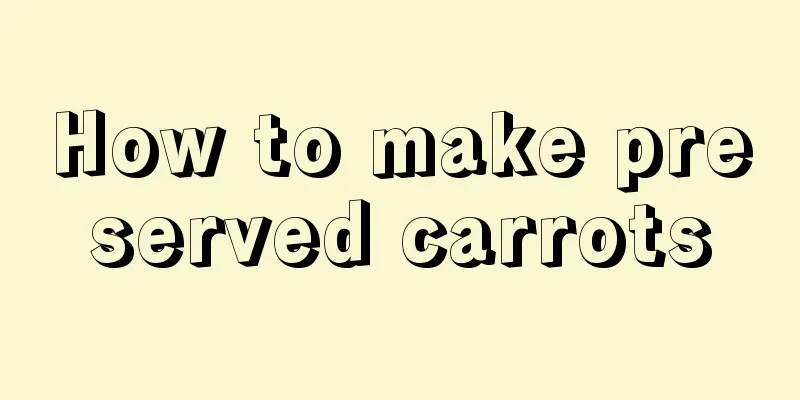How to make preserved carrots

|
Carrot preserves are a common fruit. They have a relatively high nutritional value and many children like to eat them. We know that carrots are a vegetable with a relatively high nutritional value, but their taste is really average, so children don’t particularly like them. However, if they are made into delicious preserves, it will be different. They are very convenient to eat and have very good nutritional value. How to make preserved carrots [Ingredients] 1000g carrots, 120-200g yellow rock sugar (if you like the surface to be sweeter, you can add 200g sugar), 1 cup of Nami water [Tools] Tupperware multi-purpose pot, Tupperware whirling plane, Tupperware deli knife [practice] 1. Wash 1000g carrots, peel them with a Tupperware whirlwind peeler, and cut them into round slices with a Tupperware deli knife. Put them into a Tupperware multi-purpose pot, add 120g yellow rock sugar, and a cup of Nami water; 2. Cook at 800W until the water seeps out. If there is a lot of water, you can increase the heat to dry it out, then adjust to 300W to slowly dry the carrot slices; 3. During the baking process, stir the carrots with a spatula from time to time until the surface of the carrots is dry or frosted, then turn off the heat; 6. After it has cooled, you can seal it in a Tupperware refrigerator box and eat a few slices a day to supplement your nutrition. It has the effect of nourishing the liver and improving eyesight. It is a very healthy snack for children! The efficacy and function of carrots 1. Enhance immunity: The lignin in carrots can enhance the body's immune ability and indirectly eliminate cancer cells. 2. Lowering blood sugar and blood lipids: Carrots contain substances that lower blood lipids, can promote the synthesis of adrenaline, and also have blood pressure lowering and cardiotonic effects. They are an excellent food therapy for patients with hypertension and coronary heart disease. 3. Nourish the liver and improve eyesight: Carrots contain a large amount of carotene. After entering the body, it is acted upon by enzymes in the liver and small intestinal mucosa, and 50% of it is converted into vitamin A, which has the effect of nourishing the liver and improving eyesight, and can treat night blindness. 4. Benefit the diaphragm and relax the intestines: Plant fiber increases gastrointestinal motility, promotes metabolism, promotes bowel movements and prevents cancer. |
>>: How to make preserved bayberry
Recommend
Secret recipe of Taiwanese braised pork rice
Economic development has put us under increasing ...
How to make Cordyceps soup for autumn and winter
When you come back from a day's work, you mus...
How to make coffee walnut toast
Cooking seems so simple in the eyes of many peopl...
How to fry clams
Clams have tender meat, are rich in nutrients and...
How to cook Cordyceps duck
The preparation of Cordyceps Duck is not as diffi...
Super quick braised chicken feet recipe
Food is the most important thing for people, so a...
How to make beef udon noodles with oyster sauce
Whenever your stomach growls, you will most likel...
How to make twice-cooked pork with black bean sauce and tea tree mushroom
Whether our diet is healthy or not is often direc...
How to make golden soup with flowering chrysanthemum
The method of soaking flowering chrysanthemum in ...
How to make vegetable porridge vs pickled vegetables
The same dish will definitely taste different whe...
How to make Yibin Yanmian
Our great China is vast and rich in resources, an...
How to make marinated pork liver
Nowadays, many office workers bring their own lun...
Beef, carrot and millet porridge recipe
Every time you visit friends or colleagues’ homes...
How to make sweet soup with ginkgo, honey beans and white fungus
There are actually many things to pay attention t...
How to make chocolate brownies
Food requires nutritional balance. Not only will ...









